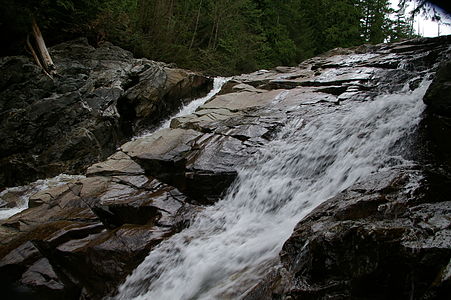Upper Twin Falls
History
The park originated in 1950, when Washington State Parks purchased a 160-acre parcel from Puget Sound Power and Light. Originally named Twin Falls State Park, following the park's expansion in 1976 its name was changed to Olallie, after a Chinook word for the berries which are common in the park.
Features
The park features old-growth forests and five notable waterfalls: Twin Falls, Middle Twin Falls, Upper Twin Falls, Weeks Falls, and Upper Weeks Falls.
Twin Falls features a well-hidden underground run-of-the-river hydroelectric project that generates 24 MW of electricity. The powerhouse is located 325 feet (99 m) below ground.
Activities and amenities
Park activities include fishing, hiking, mountain biking, bird watching, and rock climbing. Completed in 2017, the Ollalie Trail added 9.2 miles (14.8 km) of backcountry mountain biking.
References
- ^ "Twin Falls State Park". Geographic Names Information System. United States Geological Survey, United States Department of the Interior.
- ^ "Olallie State Park". Washington State Parks and Recreation Commission. Retrieved May 11, 2015.
- ^ Karen Sykes (April 24, 2002). "Hike of the Week: Big trees, waterfalls and spring flowers". Seattle PI. Take a Hike. Retrieved March 31, 2007.
- ^ "Twin Falls, King County". Northwest Waterfall Survey. April 24, 2002. Retrieved March 31, 2007.
- ^ "Twin Falls Hydroelectric Project". Archived from the original on March 4, 2016.
- ^ "New backcountry trail opens at Olallie". Mountains to Sound Greenway Trust. October 1, 2017. Retrieved October 25, 2017.
External links
- Olallie State Park Washington State Parks and Recreation Commission
- Olallie State Park Map Washington State Parks and Recreation Commission




